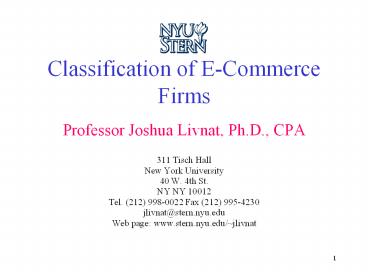Classification of E-Commerce Firms - PowerPoint PPT Presentation
Title:
Classification of E-Commerce Firms
Description:
... http://ecommerce.ncsu.edu/business_models.html Brokerage Bringing buyers and sellers together Buy/sell fulfillment Online stock trading Market exchange B2B ... – PowerPoint PPT presentation
Number of Views:609
Avg rating:3.0/5.0
Title: Classification of E-Commerce Firms
1
Classification of E-Commerce Firms
- Professor Joshua Livnat, Ph.D., CPA
- 311 Tisch Hall
- New York University
- 40 W. 4th St.
- NY NY 10012
- Tel. (212) 998-0022 Fax (212) 995-4230
- jlivnat_at_stern.nyu.edu
- Web page www.stern.nyu.edu/jlivnat
2
Classifications
- Classification by seller/buyer
- Classification by product or activity
- Classification by sources of revenues
3
Classification by seller/buyer
- Business to Consumer (B to C)
- Southwest Airlines generates over 15 of its
revenues from its online site. http//www.southwes
tairlines.com/ - Business to Business (B to B)
- Automobile manufacturers organizing an exchange
to buy components from suppliers.
http//www.generalmotors.com/cgi-bin/pr_display.pl
?1202 - Consumers to Consumers (C to C)
- Auctions sites like E-Bay. http//www.ebay.com/
- Consumers to Business (C to B)
- Selling information to businesses like gorefer.
http//www.gorefer.com/ - http//www.mercata.com/
4
Classification by product or activity
5
Classification by Revenue Sources
- Revenues from selling products or services
- Traditional sales http//www.amazon.com
- Commissions http//www.priceline.com/
- Per-transaction fees http//www.nytimes.com/
- Advertising revenues - See Appendix A
- Referral fees See Appendix B
- per referral
- fixed amount
- percentage of transaction
- Market creation fees http//www.ebay.com/
6
Advantages of Classifications
- Classifications by seller/buyer emphasize the
markets in which the firm operates. - Classifications by product/activity emphasize the
nature of the business. - Classifications according to revenue sources
focus on the underlying business model. - An E-Commerce company is likely to be in more
than one category. - The analysis of categories helps in profiling the
business (segments).
7
Warning
- The Following Definitions of Various Business
Models are not mine. - They were developed by Professor Michael Rappa
- http//ecommerce.ncsu.edu/business_models.html
8
Brokerage
- Bringing buyers and sellers together
- Buy/sell fulfillment
- Online stock trading
- Market exchange
- B2B (metals exchange)
- Virtual mall
- Internet fashion mall
- Auction broker
- E-Bay
- Search agent
- My Simon, Dealtime
- Fee per transaction
9
Advertising
- Free content or services to users. Content
(service) providers get advertising revenues. - Model in existence for radio and TV.
- Need very high volume or very specialized
audience. - Generalized portals.
- Personalized and specialized portals.
- Attention/incentive marketing.
- Free products or services.
- Bargain discounters.
10
Infomediary
- Collecting and selling data about consumers,
interests and buying habits. - Sharing information among consumers
- Book reviews on Amazon
- Registration
- Collecting information on users in exchange for
access to content (newspapers, free phone
services).
11
Merchants
- Wholesalers and retailers on the Web.
- Web-based only, with no brick and mortar
operations. - Catalog services
- New form of direct mail
- BM on the Web
- Staples
- Digital content
- Music
- Software
12
Manufacturer
- Manufacturer bypasses the wholesaler to reach
final customer. - Dell
- Personalization
- Flowerbud
- Faster delivery
- May cause distribution channel conflicts
- Airlines and travel agents
13
Affiliate
- Referring to other sites
- Similar to Yellow Pages or referral fees for
lawyers. - Hitting the customer when the purse is open.
- Using information on current purchases to induce
further purchases of complementary products and
services.
14
Community
- Creating a community of similar users.
- Soliciting donations from users and foundations
- Creating knowledge networks
- Collection of experts who can respond to
questions - Sometimes experts get paid directly per question.
15
Subscription
- Pay for content
- General reluctance to pay for content on the Web.
- Exceptions
- Wall Street Journal
- Premium content (detailed stock research reports)
- Archived information
16
Utility
- Pay per use or per time
- Similar to Pay Per View movies
- Renting software and applications
- Payment per data extracted
- Credit reports
- Retrieving old publications
17
Mixture of Business Models
- Most E-Commerce firms have a mixture of business
models - Community and advertising
- Merchant and affiliate
- Business models change and continue to evolve
- The environment is very dynamic
- The need to remain flexible
18
The Business Model
- Identify the value drivers
- Number of visitors
- Number of members
- Number of transactions
- Assess the required long-term volume to make a
profit - Assess the reasonableness of the required volume
and costs to achieve it.
19
Sources of Information
- Forms filed with the SEC (http//www.sec.gov/ )
- Registration statement
- Form 10-K
- Form 10-Q
- Proxy statement
- Special reports
- Companys own Web site http//www.aol.com/
http//www.corp.aol.com/ - Investment research
- Tracking organizations http//www.mediametrix.com
20
Long-Term Business Models
- Surviving advertising models
- High volume free content services
- The broadcasting model
- Personalized and specialized content services
- Free tourist guides
- Interactive models
- Surviving community models
- Right demographics
21
Long-Term Business Models
- Surviving brokerage models
- Only if BM do not offer their own services
- Merchants
- Only if reduces transaction costs or increases
the pie - Affiliates
- Will it be pay per referral? Pay per listing
(like Yellow Pages)?
22
Long-Term Survival
- Depends on the long-term tradeoff between
revenues and costs. - Cheap initial financing masks true long-term
costs. - The recent decline in prices of Internet stocks
can force people to think through more carefully
of the long-term viability of the business model.
23
Summary
- Classifications help think about the business
model. - Classifications also help in assessing the
long-term viability of the business.































